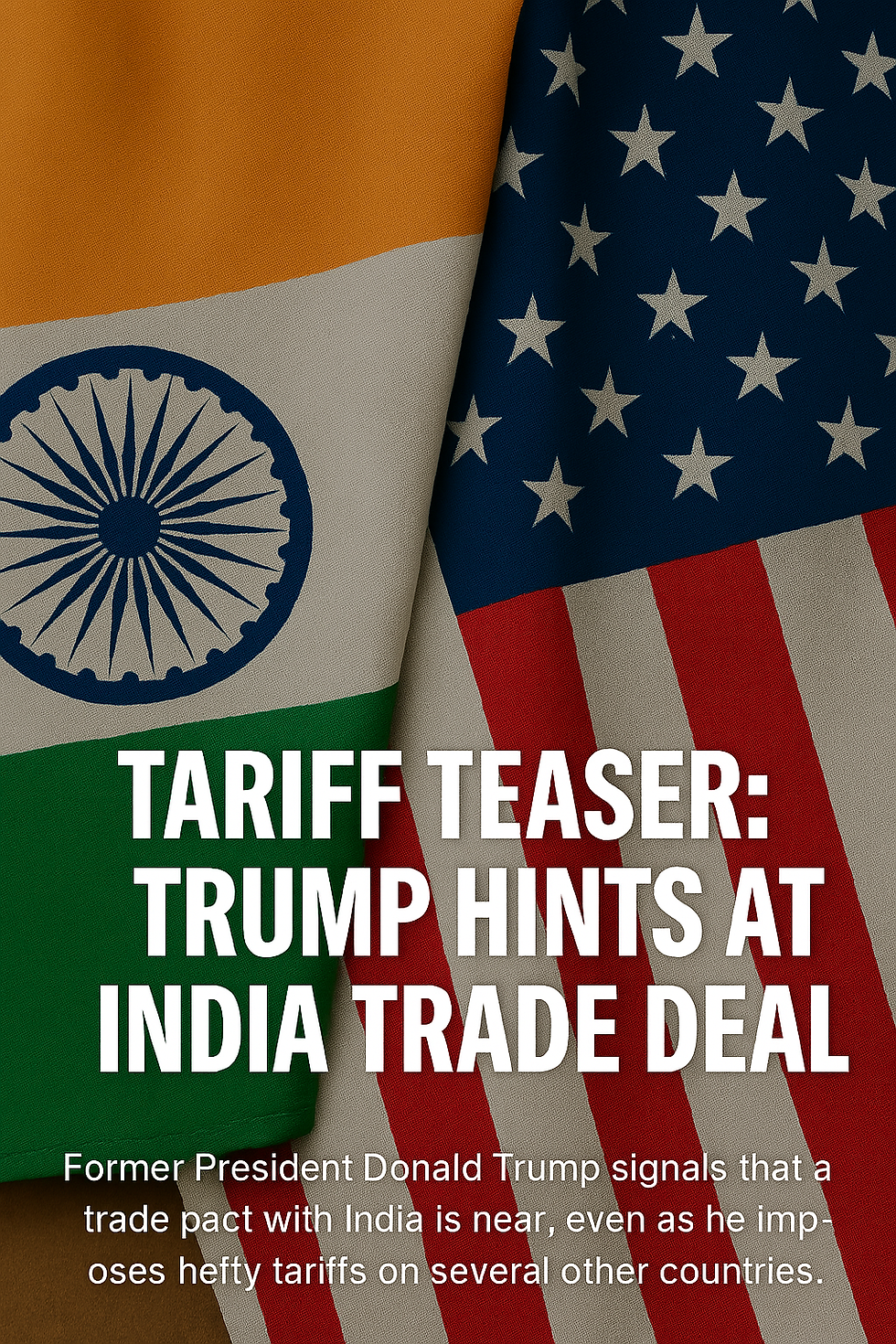July 9 marks the end of the 90-day suspension.
- yakub Pasha
- Jul 8
- 4 min read
Sibel’s Monologue: “Tariffs, Textiles, and Tectonic Shifts”
So here we are—July 2025, and the India–US trade pact is dancing on the edge of a deadline. Former President Donald Trump has declared the deal is “close,” while simultaneously slapping 25–40% reciprocal tariffs on 14 countries, mostly in ASEAN, starting August 1. India, notably, is not on that list—yet. But the clock is ticking: July 9 marks the end of the 90-day suspension on Trump’s earlier 26% tariff on Indian goods.
What’s This Pact About?
It’s a mini trade deal, a precursor to a broader Bilateral Trade Agreement (BTA) expected by September–October 2025. The goal? To double bilateral trade to $500 billion by 2030. But this isn’t just about numbers—it’s about strategic alignment, economic resilience, and global positioning.
India’s Stand
Red lines drawn: No compromise on agriculture, dairy, or genetically modified crops.
Wants tariff relief on textiles, gems, leather, pharma, and electronics.
Seeks rollback of 25–50% US tariffs on steel, aluminium, and auto parts.
Advocates for digital trade equity, data privacy, and social security exemptions for Indian professionals in the US.
US’s Stand
Wants market access for agriculture, dairy, automobiles, and energy products3.
Pushing for GM crop exports, processed food, and electric vehicles.
Seeks IPR enforcement and investment liberalization, especially in multi-brand retail.
📊 Expert Views
Optimistic but cautious: Experts say a limited deal is likely, but a full pact will take longer.
Strategic credibility at stake: India must balance domestic interests with global expectations.
Investor sentiment hinges on clarity: Markets are volatile, especially in IT, pharma, and auto.
What Happens After July 9?
If no deal: India faces 26% tariffs, risking $53 billion in exports, especially in textiles, pharma, and auto parts.
If deal is struck: Boost to labour-intensive sectors, potential 0.6% GDP growth, and stronger FDI inflows.
Either way: The agriculture deadlock and IPR disputes will resurface in future negotiations.
Other Challenges & Options
Digital trade frameworks and data localization remain unresolved.
India is also negotiating with the EU, UK, and EFTA, diversifying its trade strategy.
A Social Security Agreement (SSA) with the US could benefit Indian professionals.
Sectors in Focus
Sector | India’s Gain (if deal succeeds) | US’s Gain (if deal succeeds) |
Textiles & Apparel | Tariff relief, export boost | Low-cost imports |
Pharmaceuticals | Market access, generics | IP protection, branded drugs |
Agriculture & Dairy | Protected from US competition | Market access, GM crops |
Auto Components | Tariff rollback | EV exports |
Energy & LNG | Stable imports | Long-term supply contracts |
Digital Trade | Data sovereignty | E-commerce expansion |
Investor Concerns
Volatility in export-heavy sectors until deal terms are clear.
FII flows remain cautious; clarity on tariffs and earnings needed.
Stock-specific action expected, especially in TCS, Avenue Supermarts, and Motilal Oswal.
The ripple effects of the India–US trade pact—and the surrounding tariff drama—are already being felt across continents. Let’s break it down:
Major Countries Impacted by US Tariffs (Outside India)
The US has issued tariff letters to 14 countries, with duties ranging from 25% to 40%, effective August 1, 2025:
Country | Tariff Rate | Key Sector Impacted |
Japan | 25% | Automobiles, electronics |
South Korea | 25% | Steel, semiconductors |
Malaysia | 25% | Palm oil, electronics |
Kazakhstan | 25% | Metals, energy |
Tunisia | 25% | Textiles, agriculture |
South Africa | 30% | Minerals, wine |
Bosnia & Herzegovina | 30% | Industrial goods |
Indonesia | 32% | Textiles, rubber |
Bangladesh | 35% | Garments, leather |
Serbia | 35% | Machinery, agriculture |
Cambodia | 36% | Apparel, footwear |
Thailand | 36% | Electronics, seafood |
Laos | 40% | Timber, textiles |
Myanmar | 40% | Garments, rice |
These countries are mostly part of ASEAN, and many have deep trade ties with China, which is partly why they’re being targeted.
India’s Regional Impact: States & Districts at Risk
While India isn’t on the tariff list (yet), if the India–US trade pact fails, the 26% tariff on Indian exports could return, hitting specific regions hard:
Textile Hubs
Tiruppur (Tamil Nadu) – Knitwear exports
Surat (Gujarat) – Synthetic fabrics
Panipat (Haryana) – Home textiles
Gems & Jewellery
Mumbai (Maharashtra) – Diamond polishing
Rajkot (Gujarat) – Gold jewellery
Pharmaceuticals
Hyderabad (Telangana) – Bulk drugs
Ahmedabad (Gujarat) – Formulations
Auto Components
Pune (Maharashtra) – Engine parts
Chennai (Tamil Nadu) – Transmission systems
These districts rely heavily on exports to the US and could see job losses, factory slowdowns, and investment delays if tariffs spike again.
Sibel’s Final Advice
“India’s playing a high-stakes game of economic chess. The US wants access, India wants autonomy. But here’s the twist: a smart deal isn’t about who wins—it’s about who walks away stronger. So, dear investors and policy dreamers, don’t just watch the headlines. Watch the sectors. Watch the sentiment. And above all, watch the strategy. Because in trade, as in life, the real power lies in knowing when to say yes—and when to say ‘not yet.’”
Want me to turn this into a visual digest or prep a sector-wise investor guide? I’ve got charts, sass, and strategy ready to roll.







Comments